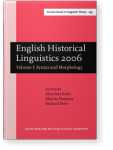Emotion verbs with to-infinitive complements: From specific to general predication
This paper traces the evolution of to-infinitive complement constructions with the emotion matrix verbs like, love, hate and prefer over the past two hundred years. It proposes that when the matrix verb is not preceded by a modal auxiliary these constructions should be analysed in Present-day English as encoding general rather than specific predications. In Late Modern English, on the other hand, these same constructions were widely used to encode specific predications. Using data from the BNC and the Corpus of Late Modern English Texts, the chapter demonstrates how these constructions have become increasingly restricted to encoding general predications over the past two hundred years. This development is related to the parallel expansion of -ing complement constructions and of toinfinitive complement constructions with modalised matrix verbs.
Cited by (3)
Cited by three other publications
Lorenz, David & David Tizón-Couto
2024.
Coalescence and contraction of V-to-Vinf sequences in American English – Evidence from spoken language
.
Corpus Linguistics and Linguistic Theory 20:1
► pp. 1 ff.

This list is based on CrossRef data as of 11 july 2024. Please note that it may not be complete. Sources presented here have been supplied by the respective publishers.
Any errors therein should be reported to them.
